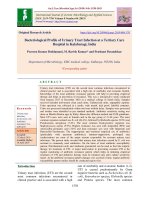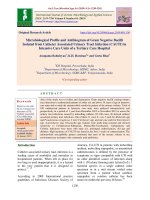Microbiological profile of urinary tract infections at a Tertiary care Hospital
Bạn đang xem bản rút gọn của tài liệu. Xem và tải ngay bản đầy đủ của tài liệu tại đây (181.99 KB, 5 trang )
Int.J.Curr.Microbiol.App.Sci (2019) 8(5): 1771-1775
International Journal of Current Microbiology and Applied Sciences
ISSN: 2319-7706 Volume 8 Number 05 (2019)
Journal homepage:
Original Research Article
/>
Microbiological Profile of Urinary Tract Infections
at a Tertiary Care Hospital
K.N. Ravichitra* and U. Srinivasa Rao
Department of Microbiology, ASRAM Medical College, Eluru- 534005,
West Godavari dist, Andhra Pradesh, India
*Corresponding author
ABSTRACT
Keywords
Microbiological
Profile,
Urinary Tract
Infections,
Bacteriuria
Article Info
Accepted:
15 April 2019
Available Online:
10 May 2019
Urinary tract infection (UTI) is one of the more common medical problems. It is
an inflammatory response of the urothelium to bacterial invasion that is usually
associated with bacteriuria and pyuria. Common disorder is accounting for 1-3%
of consultations in general medical practice. A total of 3835 urine samples
collected from clinically suspected urinary tract infection were subjected to
microbiological investigations. Out of 3835 urine samples processed, 1756
(45.8%) samples showed significant growth. Escherichia coli (48.9%) was the
most common organism isolated followed by Klebsiella (32.6%). Our study
showed that majority (61.2%) of the positive samples belonged to 21-40 years.
Sensitivity to nitrofurantoin and amikacin was good in our study when compared
to other drugs. This study shows the isolation rate of various uropthogens and their
sensitivity to commonly used drugs for the treatment of UTI.
Introduction
Urinary tract infection (UTI) is a term that is
applied to a variety of clinical conditions
ranging from asymptomatic presence of
bacteria in the urine to severe infection of the
kidney with resultant sepsis.1 Urinary tract
infections may involve just the lower tract or
both the lower and upper tracts. 2 They are a
common cause of morbidity and can lead to
significant mortality. They account for 1-2%
of all office visits by women and 0.6% of all
office visits by men.3 The uropathogens
causing UTI vary by clinical syndrome but
are usually enteric gram negative rods that
have migrated to the urinary tract.4 Most
common organisms in community include
Escherichia
coli,
Proteus
species,
Pseudomonas species, Streptococci and
Staphylococcus epidermidis.5 In hospital
acquired UTIs a wider variety of causative
organisms are found though Escherichia coli
still predominates. The incidence of
bacteriuria
also
increases
with
institutionalization or hospitalization and
concurrent disease. Most UTIs are caused by
1771
Int.J.Curr.Microbiol.App.Sci (2019) 8(5): 1771-1775
a single bacterial species. Choosing
judiciously whether to initiate antibiotic
therapy and then selecting the most urinary
focused agent for the shortest appropriate
duration are important factors in global efforts
to stem the rise of antimicrobial resistant
organisms.
The available data demonstrates a worldwide
increase in the resistance to antibiotics
commonly used to treat UTI.
Hence this study was undertaken to identify
various etiological agents causing urinary
tract infection, to evaluate antimicrobial
susceptibility pattern of those isolates, to
study the effect of age and sex in the
causation of UTI.
Materials and Methods
This is an observational study conducted in
the Department of Microbiology, ASRAM,
Eluru. Urine samples of both inpatients and
outpatients of clinically suspected urinary
tract infections received in the department for
aerobic culture and sensitivity during January
2018 and December 2018, of both sexes and
of all age groups were included in the study.
Mid stream urine collected in a sterile wide
mouthed container was processed.
After preliminary screening by Gram staining,
isolation of urinary pathogens was done on
MacConkey and blood agar by surface streak
procedures using calibrated loops for semiquantitative method. 6, 7 Confirmation of the
isolated organism was done by Gram staining,
hanging drop method of motility testing,
catalase, oxidase and other biochemical
reactions.
Antibiotic sensitivity testing
Was performed according to CLSI guidelines
on Muller-Hinton agar by Kirby-Bauer disc
diffusion method. Commercially available
antibiotic discs of Himedia were used.
Results and Discussion
A total of 3835 urine samples were
considered for the study, of them 2560 were
from outpatients and 1275 from inpatients. Of
the total samples significant growth was seen
in 1756 samples (45.8%). Of the positive
samples 502 (28.6%) were males and 1254
(71.4%) were females. Sex wise distribution
of the positive samples is shown in the table
1. Gram negative organisms 1510 (85.9%)
predominated in our study in comparison to
the gram positive organisms 246 (14%). 1377
(91.2%) of 1510 samples belonged to
enterobacteriaceae
family.
Various
uropathogens isolated is shown in the chart
1.Our study showed that majority 1075
(61.2%) of the positive samples belonged to
21-40 years. Age wise distribution of the
positive samples is shown in the chart 2.
Sensitivity to nitrofurantoin 90.5% and
amikacin 87% was good in our study,
followed by ciprofloxacin 87%. Sensitivity to
ceftriaxone and ceftazidime was moderate in
our study. Whereas sensitivity to amoxyclav
was only 32.4%. All the Gram positive
organisms showed low resistance to linezolid.
UTIs are the result of interactions between the
uropathogens and the host. 45.8% of samples
showed growth of various pathogens in our
study which is similar to Ruchi Mishra et al.,
43.6%.9 Positivity of females in our study was
71.4% which is similar to the study conducted
by Latika Jshch et al., 77.40%.10 61.2% of
positive samples in our study were of the age
group 21-40 years, similar to Shamataj
Kattalagere Razak et al.,11 Gram negative
organisms predominated in our study in
comparison to gram positive organisms,
which is similar to other studies. Escherichia
coli 43.9% is the predominant uropathogen in
our study which is similar to Salwa H.
Alkhyat et al., 45.2%. 12
1772
Int.J.Curr.Microbiol.App.Sci (2019) 8(5): 1771-1775
Table.1 Sex wise distribution of positive samples
Sex
No of positives
502
Males
1254
Females
1756
Total
% of positives
28.6
71.4
100
Chart.1 Various uropathogens isolated
Chart.2 Age wise distribution of positive samples
1773
Int.J.Curr.Microbiol.App.Sci (2019) 8(5): 1771-1775
The present study also showed 32.6% of the
isolates were Klebsiella, similar to Akhilesh
kumar et al., 32.8%.13 Our study showed that
there is increasing rate of isolation of
klebsiella as uropathogen. Proteus species
constituted only 1% of isolates in our study
which is almost similar to Bhatt CP et al., 14
7.6% of the isolates in our study belonged to
pseudomonas aeruginosa, while Iregbu et al.,
reported 8.4%.15 Isolation of Coagulase
Positive Staphylococci as uropathogen in our
study was 2.7% while Preethishree et al.,
reported 3.97%. The present study showed
that sensitivity to nitrofurantoin and amikacin
was good, similar to the study conducted by
Vasuki Balasubramanyam.17
In conclusion, treatment of UTI accounts for a
major proportion of antimicrobial use in
ambulatory care, inpatient care and long term
care settings. Responsible use of antibiotics
for this common infection has broad
implications
for preserving antibiotic
effectiveness into future.
7.
8.
9.
10.
11.
References
1. Emil A Tanagho, Jack W Mc Aninch.
2009. Smith’s General Urology:17th
edition,193-197.
2. Geo F. Brooks., Karen C. Carroll et al.,
2007. Jawetz, Melnick & Adelberg’s
Medical Microbiology. 24th edition, 743747.
3. Anthony J Schaeffer., Edward M.
Schaeffer.
2012.Campbell
–Walsh
Urology. 10th edition, 257-262.
4. Kalpana Gupta., Barbara W. 2018.
Harrisons’s Principles of Internal
Medicine. 20th edition, 968-970.
5. B Conway et al., 2018. Davidson’s
Principles and Practice of Medicine. 23rd
edition, 426-429.
6. J. Gerald Collee., Barrie P. Marmion et
al., 2012. Mackie & Mc Cartney:
12.
13.
14.
1774
Practical Medical Microbiology: 14th
edition, 413-418.
Elmer W. Koneman et al., 2006. Color
Atlas and Textbook of Diagnostic
Microbiology. 6th edition. Baltimore:
Lippincott Williams Wilkins.
Franklin R. Cockerill. 2012. CLSI
Performance Standards for Antimicrobial
Disk Susceptibility Tests; Approved
Standard: Eleventh Edition. CLSI
document M02-A11.
Ruchi
Mishra
et
al.,
2016.
Bacteriological profile and sensitivity
pattern of microorganisms causing
Urinary Tract Infection at a tertiary care
center in eastern Uttar Pradesh.
International Journal of Biomedical and
Advance Research. 7(6), 292-297.
Latika J Shah et al., 2015. Urinary tract
infection: Bacteriological profile and its
antibiotic susceptibility in western India.
National Journal of Medical Research. 5
(1), 71-74.
Razak SK and Gurushantappa V. 2012.
Bacteriology of urinary tract infection and
antibiotic susceptibility pattern in a
tertiary care hospital in South India. Int J
Med Sci Public Health. 1(2), 109-112.
Salwa H. Alkhyat and Maher Ali
Al.Maqtari.
2014.
Prevalence
of
Microorganisms isolates from Urinary
Tract Infections at Some Hospitals in
Sana'a
City,
Yemen.
Int.J.Curr.
Microbiol.App.Sci 3(6), 876-885.
Akhilesh Kumar and Rajiv Kumar et al.,
2017. Antimicrobial susceptibility pattern
of urine culture isolates in a tertiary care
hospital of Jharkhand, India. International
Journal
of
Basic
&
Clinical
Pharmacology. 6 (7), 1733-9.
Bhatt CP., Shrestha et al.,2012.Etiology
of Urinary tract infection and drug
resistance cases of Uropathogens. Journal
of Kathmandu Medical College, 1,2( 2),
114-120.
Int.J.Curr.Microbiol.App.Sci (2019) 8(5): 1771-1775
15. Iregbu KC et al., 2013.Urinary tract
infections in a tertiary hospital in Abuja,
Nigeria. African journal of clinical and
experimental microbiology. 14(3), 169173.
16. Preethishree et al., 2016. Uropathogens
and their Antibiotic Susceptibility Pattern
at a Tertiary Care Teaching Hospital in
Coastal
Karnataka,
India.
Int.J.Curr.Microbiol. App.Sci. 5(1), 2331.
17. Balasubramanyam V and Sharma NL.
2017. Clinical profile and gram negative
bacterial profile of urinary tract infection
in children attending a tertiary care
hospital of Tamilnadu, India. Int J
Contemp Pediatr 4(1), 231-3.
How to cite this article:
Ravichitra, K.N. and Srinivasa Rao, U. 2019. Microbiological Profile of Urinary Tract
Infections at a Tertiary Care Hospital. Int.J.Curr.Microbiol.App.Sci. 8(05): 1771-1775.
doi: />
1775









